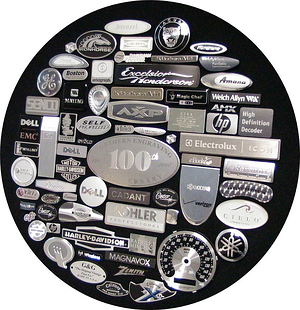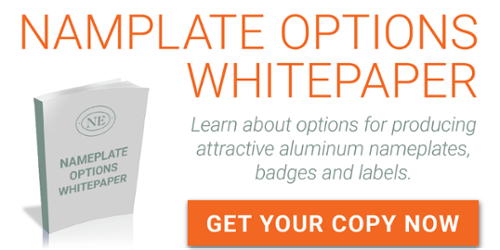5 Common Nameplate Specifications
 Nameplate Specifications
Nameplate Specifications
Discussions held during the design of aluminum nameplates and badges often center on reviewing the specifications that are needed. Specs include items such as material regulations, scratch or chemical resistance, exposure to certain elements like sunlight or salt water, adhesive needs and best substrate.
These can be easy to overlook or assume that all nameplate and label suppliers have the same capabilities. Specifications are typically communicated on the blueprint with the dimensions and artwork details. They also can be a separate document as part of the Quality requirements. A third option is to provide the requirements over email with Customer Service or Sales Manager.
Here are the top five specifications that are routinely reviewed for nameplate, badge and label requirements.
1. RoHS2/REACH and Conflict Material Compliance
Manufacturing companies are held to specific standards with regards to the materials which are used in production. As a result, OEM customers typically require compliance to these standards when considering the branding for the end product. Proof of compliance is available upon written request through your Customer Service Representative.
2. Surface Reliability
Many times there is a requirement for the surface of a nameplate or decorative overlay to stand up to the possibility of being scratched or exposed to specific cleaners. Protective top coats are used to satisfy this need.
3. Exposure to the Elements
Exposure to various climates, tempurature, levels of humidity and sunlight can be an important element to review when thinking about your brand identity. Some processes or materials may perform better than others. Protective top coats can be used as well as reviewing for alternative substrates to maximize results.
4. Adhesives
A wide range of adhesives are available in nameplate and label manufacturing. Common specifications call for the 3M brand. Equivalent alternatives can be identified as well. Recommendations are made based on the substrate the nameplate is applied to and the specific guidelines the bond needs to meet.
5. Material
Consider the role that your nameplate or overlay will play in your branding. Does your application require backlit graphics? Are you looking to enhance your brand? A variety of options are available.
Metal nameplates and trim offer a premium appearance. Decorating options include standards printing and screening processes as well as the opportunity to enhance further with mechanical finishes.
Pulling it Together
Attention to detail and understanding the specification requirements for your project are key to ensuring a quality product. These requirements should be reflective of your specific application and industry. The more information that is shared up front, the better as we work to provide you the most cost effective solution for your aluminum nameplates and badges.
Related Posts for Nameplate Specifications
RoHS 2/REACH Overview
Nameplate Testing and Specifications
Basic Adhesive Options for Nameplates
Essential Checklist for Nameplate Design
Have more questions? We're here to help! Let's talk!
Editor's note: this post was originally published in April 2015 and has been updated for completeness and clarity.
Subscribe to Nameplate Blog
- 2021 (1)
- 3D (4)
- Adhesives (11)
- Aluminum (129)
- Aluminum In-mold (9)
- Aluminum Trim (41)
- Anodize (4)
- Appliance (12)
- Appliqué (5)
- Archive (35)
- Artwork Submission (4)
- Assembly (6)
- Automotive (35)
- Backlit (5)
- Boats (6)
- Brass (8)
- Brushed Aluminum (19)
- Carbon Fiber (2)
- Classic (1)
- Coined (5)
- Color Development (25)
- Computers (13)
- Cosmetics (24)
- Custom Patterns (11)
- Customization (16)
- Customized Patterns on Aluminum (2)
- Debossing (13)
- Diamond Cut (22)
- Digital Printing (2)
- ebook (4)
- Electronics (23)
- Embossing (53)
- Etched (20)
- Exterior (9)
- FAQ (29)
- Faux Finish (1)
- Faux Finishes (7)
- Favorite Nameplate (20)
- Furniture (9)
- Gauges (5)
- Gloss (4)
- Hang Tag (1)
- IDSA (1)
- In-mold Decoration (5)
- Individual Letters (7)
- Inlay (1)
- Key Fob (1)
- Labels (10)
- Large Vehicle (4)
- Laser Etch (2)
- Lithography (3)
- Match Box Cover (6)
- Materials and Processes (118)
- Mechanical Finishes (51)
- Medical Equipment (10)
- Metallic (8)
- Motorcycle (11)
- Nameplate (175)
- Nameplate Examples (54)
- Nameplate Tools (7)
- Outdoor Equipment (4)
- Overlay (7)
- Packaging (15)
- Patina Finish (3)
- Plastic (1)
- Plastic Trim (3)
- Point of Purchase (8)
- Polycarbonate (10)
- Process Color (16)
- Promotional Products (38)
- Prototypes (2)
- Recreational Vehicles (6)
- Resources (11)
- Safety Labels (2)
- Selective Patterns (10)
- Sill Plate (6)
- Sports Equipment (9)
- Stainless Steel (17)
- stock dies (10)
- Surfaces (4)
- Sustainability (1)
- Technical (1)
- Telecommunications (9)
- Testing (3)
- Texture (15)
- Top 10 (9)
- Woodgrain (2)






